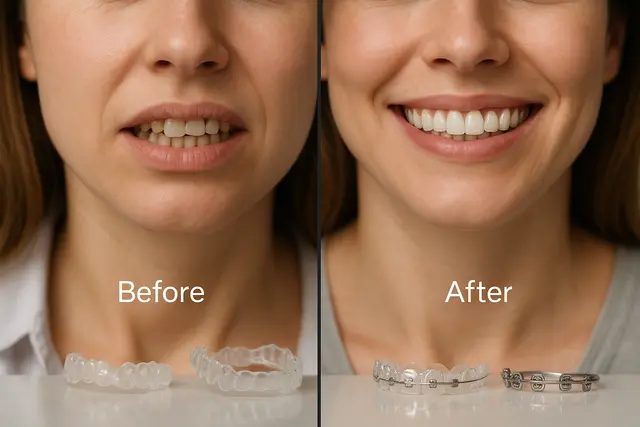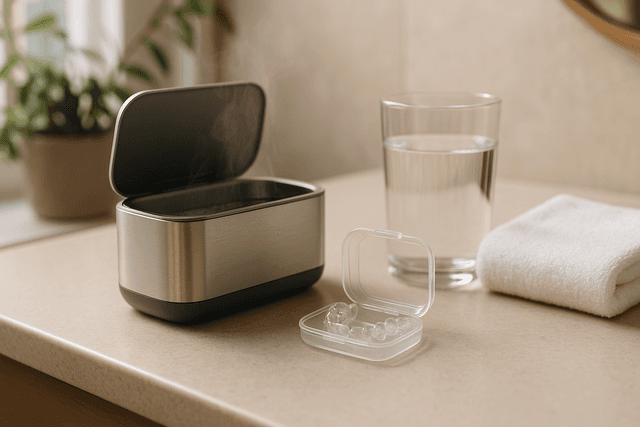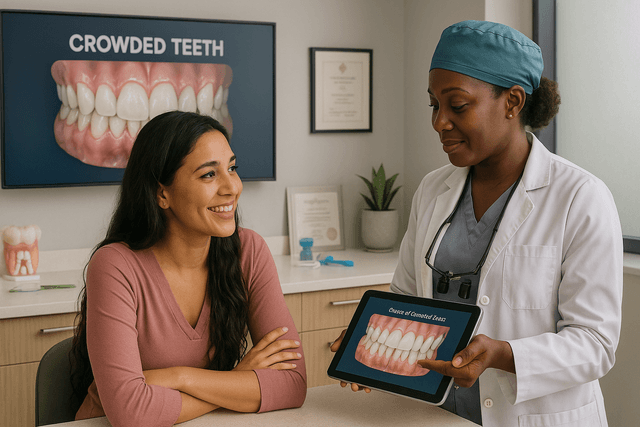Orthodontics
Retainer With Braces on Them: Benefits and Drawbacks
Retainers with braces on them are a unique orthodontic solution designed to maintain your smile while making small adjustments to tooth alignment. By combining the stability of a retainer with the corrective power of brackets, they offer a middle ground for patients who need fine-tuning after traditional braces.
6 min read
Aug 13, 2025

If you’ve ever finished orthodontic treatment and thought you were done with metal in your mouth forever, the idea of a retainer with braces on them might sound like a plot twist. This isn’t your run-of-the-mill retainer after braces. We’re talking about a hybrid device that combines the holding power of a retainer with the corrective touch of orthodontic brackets. It’s like braces and retainers had a baby, and yes, it actually serves a purpose.
Understanding the Retainer
A retainer’s main job is to keep your teeth straight after the braces are removed. Think of it as the bodyguard for your alignment of teeth. Without it, teeth love to wander. Even the most perfect smile can shift over time. Whether it’s a Hawley retainer, clear retainer, or another type of retainer, the mission is the same: prevent teeth from moving back to their old ways.
When you wear a retainer regularly, you’re not just protecting your smile, you’re preserving the investment of your orthodontic journey. And if you skip it? Teeth shifting becomes a real possibility.
The Role of a Bracket
A bracket is a small, often square piece that attaches to your tooth, serving as the anchor point for a wire in braces. In the case of a retainer with brackets, those tiny squares are part of the design. They can deliver gentle adjustments even after you’ve technically finished treatment. This makes them different from a standard braces retainer or removable retainers.
Sometimes these devices are used if your teeth haven’t changed much, but your orthodontist notices a minor relapse in positioning. They can fine-tune things without putting you back into full real fixed braces.
Why a Brace Still Matters
For some patients, a brace-like component in a retainer can help correct small rotations or maintain the proper positioning of teeth that are stubborn. While not as heavy-duty as the real fixed braces you might have worn before, they can still guide teeth to move slightly, preventing bigger problems later.
It’s a little like having a fake braces appliance, except it’s crafted with premium orthodontic materials and an actual purpose, not just the look of real braces.
How Orthodontic Devices Evolve
Orthodontic care has come a long way. There are now more retainers available than ever, including clear plastic trays, Hawley designs, and hybrids that work like braces. Orthodontic retainers can be removable or permanent, depending on what’s best for your case.
When your treatment is complete, your orthodontist might suggest a specific type of retainer based on your bite, gum health, and how your teeth respond after braces are removed.
The Hawley Retainer Classic Reliability
The Hawley retainer has been around for decades, and for good reason. Made with a metal wire across the front teeth and an acrylic plate on the roof of your mouth or behind your lower front teeth, it’s durable, adjustable, and can last for years. Hawley retainers are custom-made using a dental impression or an impression kit so you get a perfect fit.
While it’s not as invisible as a clear retainer, it’s tough to beat in terms of long-term dental health benefits.
Choosing the Right Type of Retainer
There are three basic types you’ll hear about after getting your braces off: Hawley, clear plastic trays, and permanent retainers. Each type of retainer has its pros and cons:
Hawley: Adjustable and durable, but visible.
Clear retainer: Discreet and lightweight, but may crack if not cared for.
Permanent retainer: Bonded behind the teeth, keeps them in place 24/7, but requires extra flossing effort to protect your teeth and gums.
For a retainer with brackets, you’re looking at a specialized version of these that allows small orthodontic movements while still acting like a retainer.
When You Need a Retainer With Brackets
A retainer with brackets might be recommended if your teeth have shifted slightly after braces are removed, or if your orthodontist spots minor imperfections in the alignment. This is especially helpful for the lower front teeth, which can be tricky to keep perfectly straight.
It can also be a way to mimic the effect of braces online but in a legitimate, medically supervised way, not a fake braces retainer from the internet.
Hawley and Other Options
Hawley devices can even incorporate orthodontic brackets for fine-tuning. That means you can benefit from the adjustability of a Hawley while still guiding your teeth using light orthodontic forces. A dental laboratory crafts these to your exact dental impression, so they’re truly custom-made.
The result? A retainer process that’s tailored to your mouth, giving you the best for your teeth without restarting full orthodontic treatment.
The Dental Side of Things
Your dentist and orthodontist work together to make sure your dental health stays on track while you’re wearing the retainer. Brackets and wires can trap food, so brushing and flossing become even more important. Gum health is key because inflammation can slow progress or even cause setbacks.
Clear plastic trays or Hawley retainers without brackets are easier to clean, but they don’t offer the same fine-tuning capability.
Retainer After Braces What to Expect
When you get a retainer after your braces, whether it’s standard or has brackets, the goal is keeping your teeth from shifting. If you skip wearing the retainer, teeth can and will start to move. Even if your teeth haven’t changed much yet, prevention is a lot easier than correction.
You may need to wear a retainer full-time initially, then gradually switch to nights only. Your orthodontist will guide you based on your progress and your specific orthodontic care needs.
Why Clear Retainers Are Popular
A clear retainer made from clear plastic is nearly invisible, making it a favorite among adults and teens alike. While they can’t incorporate brackets in the same way as a Hawley, some hybrid versions use clear trays with small attachments for targeted movement.
These are perfect for those who want the benefits of fine-tuning without the full look of real braces.
Orthodontic Retainers How They Keep Your Smile in Place
Orthodontic retainers, whether they’re teeth retainers made of clear plastic or Hawley acrylic, all share one mission: keeping your teeth straight for the long haul. Types of retainers after braces vary in style and function, but they’re all custom-made for a perfect fit.
If your teeth have shifted or your alignment of teeth isn’t quite what you wanted after treatment is complete, a retainer with brackets may be the most efficient way to get back on track.
Working With a Tray Design
A tray-style retainer, like clear aligners, hugs your teeth using a dental impression to mold it. It can be upper and lower, depending on your needs. Some are purely for retention, while others, when designed with small attachments, act more like braces.
They’re removable, so you can eat, brush, and floss normally, but you’ll need to wear your retainer as directed to protect your straight teeth.
The Truth About Clear Plastic in Retainers
Clear plastic retainers are sleek and discreet, but they need gentle care. Avoid hot water, which can warp them, and store them in a case to prevent cracks. They may not last as long as a Hawley, but for many people, the invisibility is worth it.
A clear plastic tray with minor bracket-like attachments offers the best of both worlds: cosmetic subtlety and orthodontic function.
Upper and Lower Retainers Matching the Set
Your orthodontist might recommend an upper and lower set if both arches need attention. This is especially true if you’ve had significant work done to keep your teeth straight and your bite balanced.
The retainer process will depend on your dental impression, bite, and whether you’re using removable retainers or a permanent retainer bonded behind the teeth.
Keeping Your Teeth and Gums Healthy
No matter what type you choose, brushing, flossing, and regular orthodontic care checkups are non-negotiable. Brackets can trap plaque, clear plastic can hide buildup, and even a metal wire from a Hawley can collect food particles.
Keeping your teeth and gums healthy ensures that your investment lasts and your perfect smile stays that way.
What Is a Retainer With Braces on Them?
A retainer with braces on them is a hybrid orthodontic device that combines the holding function of a retainer with the corrective capabilities of brackets and wires. Unlike standard retainers, this type can make small adjustments to tooth position while maintaining alignment. It’s often used when teeth have shifted slightly after braces, allowing for fine-tuning without returning to full orthodontic treatment.
When Would an Orthodontist Recommend a Retainer With Brackets?
An orthodontist may suggest a retainer with brackets if they detect minor relapse or subtle imperfections in your alignment after braces have been removed. This is especially helpful for correcting small rotations or gaps without resorting to traditional braces. The device can be customized to your bite and may be part of a short-term, targeted treatment plan.
What Are the Benefits and Drawbacks of This Type of Retainer?
The main benefits include the ability to make small corrections post-treatment, maintaining proper alignment, and avoiding a full set of braces again. However, drawbacks include the need for more diligent cleaning due to brackets trapping food, potential discomfort, and being more noticeable than clear retainers. Regular dental checkups and excellent oral hygiene are essential to prevent plaque buildup and maintain gum health.
How Do You Care for a Retainer With Brackets?
Caring for this retainer involves brushing after every meal, flossing carefully around the brackets, and using orthodontic cleaning tools like interdental brushes or water flossers. Avoiding sticky or hard foods can help prevent damage to the brackets or wires. Your orthodontist may also recommend regular professional cleanings to keep both the appliance and your teeth in optimal condition.
Read Next
Related Posts

Orthodontics
Teeth Straightening Before and After: How Braces and Aligners Transform Smiles
A straight, confident smile can transform not only your appearance but also your oral health and overall well-being. Modern orthodontic treatments like braces and Invisalign make it possible to correct crowding, bite issues, and misalignments with remarkable results for patients of all ages.
5 min read
Aug 13, 2025

Orthodontics
Best At Home Retainer Cleaner Options for a Brilliant Smile
Keeping your retainer clean isn’t just about appearance, it’s essential for protecting your oral health. A well-maintained retainer prevents bacteria buildup, keeps your breath fresh, and ensures your smile stays aligned after orthodontic treatment. With the right tools and habits, you can keep it spotless from the comfort of home.
5 min read
Aug 12, 2025

Orthodontics
What Causes Crowding in Teeth? Genetics, Habits, and More
Crowded teeth aren’t just a cosmetic issue, they can affect your oral health, comfort, and confidence. Whether it’s a slight overlap or a full-on dental traffic jam, understanding what causes teeth to crowd is the first step toward getting your smile back in line.
5 min read
Jul 22, 2025
Don’t have time to research every dentist around you?
See why 30k+ patients trusted us